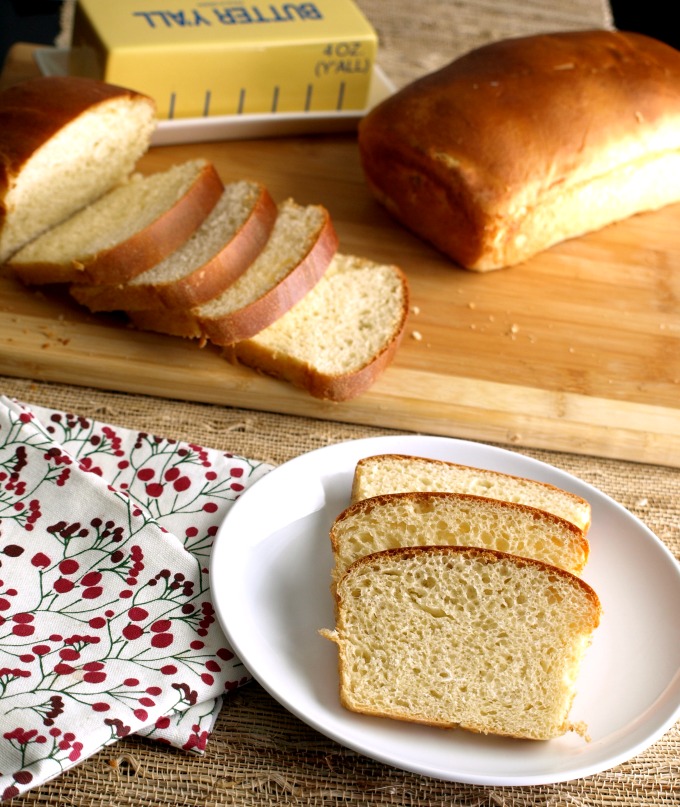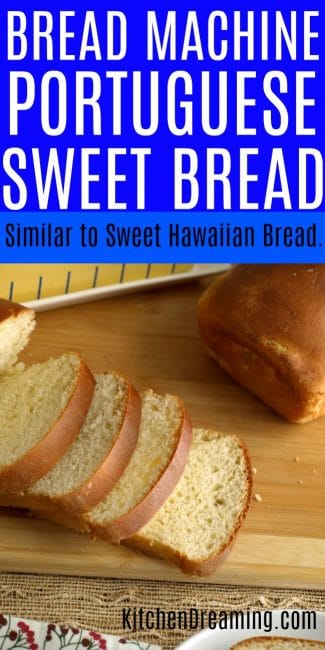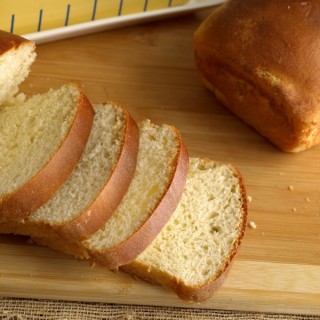Soft, fluffy, with a sweet chewy interior, Portuguese sweet bread is a delightful treat that tantalizes the taste buds with its irresistible taste and texture.

Your family will love this recipe for Portuguese sweet bread because it offers a perfect blend of sweetness and softness, making it an irresistible treat for breakfast, brunch, or dessert. With its fluffy texture and delightful flavor, it’s sure to become a beloved family favorite for all occasions.
Ingredients for Portuguese Sweet Bread
Each of these ingredients plays a crucial role in creating the desired texture, flavor, and appearance of Portuguese sweet bread. Adjusting or omitting any of them could affect the outcome of the recipe.
** You can find the full recipe ingredients and instructions on the printable recipe card below.
- All-Purpose Flour: Provides the structure and bulk of the bread. The gluten proteins in the flour give the bread its elasticity and chewiness.
- Milk: Provides moisture, fat, and proteins, which contribute to the soft texture and richness of the bread.
- Butter: Adds flavor, richness, and tenderness to the bread. It also helps create a tender crumb and a golden crust.
- Sugar: Sweetens the bread and helps feed the yeast during fermentation, aiding in the rise and development of flavor. It also contributes to the bread’s golden color when baked.
- Salt: Enhances the flavor of the bread by balancing the sweetness and helping to strengthen the gluten structure, which improves texture and volume.
- Instant Yeast: Acts as the leavening agent, causing the dough to rise by producing carbon dioxide gas during fermentation. It provides lift and lightness to the bread.
- Lemon Zest: Adds a subtle citrus flavor and aroma to the bread, enhancing its overall taste. It also provides freshness and brightness to the flavor profile.
- Eggs: Contribute richness, tenderness, and structure to the bread. The proteins and fats in eggs help bind the ingredients together and create a soft crumb.
- Vanilla Extract [paid link]: Enhances the flavor of the bread with its warm, aromatic notes. It adds depth and complexity to the overall taste profile.
How to Make Portuguese Sweet Bread
Get ready to bake up a delicious treat! Follow these simple instructions to create homemade Portuguese sweet bread that your family will adore.
** You can find the full recipe ingredients and instructions on the printable recipe card below.
- Mix wet ingredients.
- Add dry ingredients.
- Knead dough.
- Let rise.
- Shape loaves.
- Bake and enjoy!
Why this Recipe Works
This recipe works for busy families because it’s simple and requires minimal hands-on time. With easy-to-follow instructions and basic ingredients, it can be prepared quickly, allowing busy parents to enjoy homemade bread without spending hours in the kitchen. Plus, the ability to freeze the loaves for future use adds convenience for hectic schedules, ensuring there’s always a fresh, homemade option available.
Recipe Tips and Kitchen Tricks
- Room Temperature Ingredients: Ensure your milk, eggs, and butter are at room temperature before starting the recipe for optimal mixing and rising.
- Proper Kneading: Knead the dough until it’s smooth and elastic, which helps develop gluten for a better texture.
- Gentle Handling: Be gentle when shaping the loaves to avoid deflating the dough and affecting the rise.
- Grease Loaf Pans: Prevent sticking by thoroughly greasing the loaf pans before adding the dough.
- Proper Rising: Allow enough time for the dough to rise properly, as this affects the texture and flavor of the bread.
- Egg Wash: For a shiny crust, brush the loaves with an egg wash before baking.
Recipe Variations
- Raisin Bread: Fold in a cup of raisins during kneading for a classic variation.
- Orange Zest: Substitute lemon zest with orange zest for a citrus twist.
- Cinnamon Swirl: Roll out the dough, sprinkle with cinnamon sugar, roll it up, and place it in the loaf pans for a delightful swirl.
- Chocolate Chip: Mix in chocolate chips for a sweet surprise in every bite.
- Almond: Add almond extract and chopped almonds for a nutty flavor.
Serving Suggestions
- Toasted: Enjoy slices of Portuguese sweet bread toasted and spread with butter or your favorite jam for breakfast or a snack.
- French Toast: Use thick slices of bread to make indulgent French toast, served with maple syrup and fresh berries.
- Bread Pudding: Transform leftover bread into a decadent bread pudding by soaking slices in a custard mixture and baking until golden brown.
- Sandwiches: Use slices of bread to make sandwiches with your favorite fillings, such as ham and cheese or turkey and avocado.
- Bread Basket: Serve slices of bread alongside soups, stews, or salads for a comforting accompaniment to any meal.

Storing, freezing, and reheating instructions
Storing: Once cooled, store Portuguese sweet bread in an airtight container or plastic bag at room temperature for up to 3-4 days to maintain freshness.
Freezing: To freeze, wrap the cooled bread tightly in plastic wrap or aluminum foil, then place it in a freezer bag. It can be frozen for up to 1-2 months.
Reheating: To reheat frozen bread, allow it to thaw at room temperature for a few hours or overnight in the refrigerator. Then, reheat slices in a toaster, toaster oven, or conventional oven at 350°F (175°C) for a few minutes until warmed through. Alternatively, you can microwave individual slices for 20-30 seconds until warm.
Frequently Asked Questions (FAQs)
Can I use active dry yeast instead of instant yeast?
Yes, you can substitute active dry yeast for instant yeast in this recipe. However, you’ll need to activate it in warm water before adding it to the dough. Use 1 packet (2 1/4 teaspoons) of active dry yeast and dissolve it in 1/4 cup of warm water with a pinch of sugar. Let it sit for about 5-10 minutes until foamy, then proceed with the recipe as instructed.
Can I make this recipe without eggs?
Yes, you can omit the eggs from this recipe if you have dietary restrictions or preferences. The bread will still turn out delicious, though it may be slightly less rich and tender.
How do I know when the bread is done baking?
The bread is done when it’s golden brown on top and sounds hollow when tapped on the bottom. You can also use a digital thermometer to check that the internal temperature has reached 190°F


Portuguese Sweet Bread
Equipment
- bread maker
Ingredients
- 1/2 cup milk
- 4 tablespoons butter , cut into pats
- 1/3 cup sugar
- 1 1/4 teaspoons salt
- 3 1/4 cups All-Purpose Flour
- 1 tablespoon instant yeast [See Note 1]
- 1 medium lemon zested
- 2 large eggs
- 1 large egg yolk , white reserved
- 2 teaspoons vanilla extract [paid link]
Instructions
- Combine the milk, butter, sugar, and salt in a microwave-safe cup, or in a saucepan [paid link]. Heat to lukewarm. Set aside.
- In a mixing bowl [paid link], the bowl of your stand mixer [paid link], or the bucket of your bread machine [paid link], combine the flour, yeast, and stir to combine.
- Add the milk mixture, stirring first to make sure the sugar and salt aren't left in the bottom of the cup or pan. Add the lemon peel, if using.
- Add the eggs, plus one yolk, and the vanilla. Mix and knead until the dough is smooth; it’ll be very sticky at first. If you’re using a stand mixer [paid link], beat with the flat beater for about 3 minutes at medium-high speed; then scrape the dough into the center of the bowl, switch to the dough hook, and knead for about 5 minutes at medium speed. It will have formed a ball somewhat, but will probably still be sticking to the bottom of the bowl. If you’re using a bread machine [paid link], simply let it go through its entire cycle, and skip to step 6.
- Lightly grease the mixing bowl [paid link], gather the dough into a ball, and place it in the bowl. Cover, and let rise, about 1 1/2 to 2 hours. It will more than double in size. If you’re using a bread machine [paid link] and the dough hasn’t doubled in size when the cycle is complete, simply let it rest in the machine for another 30 to 60 minutes.
- Lightly grease two 8 x 4″ loaf pans.
- Gently deflate the dough, and divide it in half. Shape the dough into two loaves and place into the prepared pans. Cover the dough gently with lightly greased plastic wrap or tented foil. (see notes for braided loaves with eggs in the center).
- Let the dough rise in the pans for about 2 hours, until it’s again nice and puffy. Toward the end of the rising time, preheat the oven to 350°F.
- Mix the reserved egg white with 1 tablespoon cold water, and brush some onto the surface of the loaf; this will give it a satiny, brown crust.
- Bake the bread for 15 – 20 minutes, until it’s a medium golden brown and its internal temperature registers 190°F on a digital thermometer.
- Remove the bread from the oven, and gently transfer it to a rack to cool. Cool completely before slicing. Store at room temperature. You may also freeze the loaves for freshness for about 30 days.
Notes
- You can substitute active dry yeast for instant yeast in this recipe. However, you’ll need to activate it in warm water before adding it to the dough. Use 1 packet (2 1/4 teaspoons) of active dry yeast and dissolve it in 1/4 cup of warm water with a pinch of sugar. Let it sit for about 5-10 minutes until foamy, then proceed with the recipe as instructed.
- The dough will be very sticky at first but will tighten up as the flour has more time to absorb the water. The wet dough also makes it easier for the yeast to rise and double in size over a drier dough so resist the urge to add more flour if the dough seems too sticky heading into the first rise. Also, if you prefer not to use milk, it may easily be substituted for water.
- For 2 smaller braided loaves, start at step 7 in the instructions. Divide the dough into two, divided each half into thirds and roll it out into rope strands, and then braid it by weaving the strands. Then form the braided strands into a circle and place a plain (or dyed) hard-boiled egg into the center, and then continue with step 8 of the instructions. The bake time should be roughly the same.
- For one large braided dough, divide into thirds and roll it out into long rope strands, and then braid it by weaving the strands. Tuck the ends under the loaf to secure. Place two to three plain (or dyed) hard-boiled eggs into the loaf at intervals, and then continue with step 8 of the instructions. The bake time should be roughly the same.
